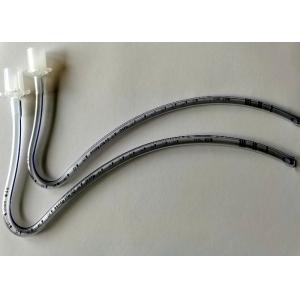
Add to Cart
6.5mm Preformed Nasal Endotracheal Tube Description:
Preformed Nasal Endotracheal Tube Uncuffed is a method of inserting a special endotracheal tube into the trachea or bronchus through the mouth or nasal cavity.
Amoung them, the Preformed Nasal Endotracheal Tube is a method of inserting a special endotracheal tube into the trachea or bronchus through the mouth or nasal cavity. And the Preformed Nasal Endotracheal Tube Cuffed is one type of it,which has high volume/low pressure cuff , to help ensuring an efficient low pressure cuff seal, and the preformed tube also helps to reduce the risk of kinking.


The preformed nasal endotracheal tube cuffed is a medical device designed for endotracheal intubation, a procedure performed to establish and maintain a clear airway for patients requiring respiratory support. Here's an overview of its features and benefits:
Features:
Preformed Shape: The tube is preformed with a gentle curve to facilitate atraumatic insertion through the nasal passage and into the trachea. This design minimizes the risk of trauma to the nasal mucosa and reduces the need for excessive manipulation during intubation.
Cuffed Design: The tube incorporates an inflatable cuff near its distal end. The cuff provides a seal against the tracheal wall, preventing air leakage and ensuring effective ventilation. It helps maintain positive airway pressure, reducing the risk of aspiration and optimizing oxygen delivery.
Reinforced Tip: The tip of the tube is reinforced to provide rigidity and facilitate atraumatic insertion into the trachea. The reinforced tip helps prevent kinking or buckling, ensuring smooth passage through the airway.
Radiopaque Marker: The tube features a radiopaque marker along its length, allowing for accurate positioning and visualization under fluoroscopy or X-ray. This aids in confirming proper placement of the tube within the trachea.
Pilot Balloon: The tube is equipped with a pilot balloon attached to the cuff. The balloon allows for inflation and deflation of the cuff, enabling precise control of cuff pressure. Proper cuff inflation helps prevent tracheal damage and ensures an effective seal.
Benefits:
Atraumatic Insertion: The preformed shape and reinforced tip facilitate atraumatic insertion, minimizing the risk of injury to the nasal mucosa and trachea.
Effective Ventilation: The cuffed design provides an effective seal, preventing air leakage and optimizing ventilation. It helps maintain positive airway pressure, reducing the risk of aspiration and improving oxygen delivery.
Accurate Positioning: The radiopaque marker allows for precise positioning of the tube under fluoroscopy or X-ray, ensuring proper placement within the trachea.
Cuff Pressure Control: The pilot balloon enables precise control of cuff pressure, preventing overinflation and minimizing the risk of tracheal damage. Proper cuff inflation ensures an effective seal and minimizes complications.
Indications:
The preformed nasal endotracheal tube cuffed is indicated for use in patients requiring endotracheal intubation for various clinical scenarios, including:
General Anesthesia: During surgical procedures, the tube is used to maintain a clear airway and provide respiratory support to patients under general anesthesia.
Respiratory Failure: In cases of severe respiratory failure, the tube is used to provide mechanical ventilation and support gas exchange.
Trauma: In trauma patients with airway compromise, the tube is used to establish and maintain a secure airway.
Critical Care: In intensive care units, the tube is used for long-term ventilation and respiratory support in critically ill patients.
Contraindications:
The preformed nasal endotracheal tube cuffed may be contraindicated in certain situations, such as:
Conclusion:
The preformed nasal endotracheal tube cuffed is a valuable medical device used in endotracheal intubation procedures. Its preformed shape, cuffed design, reinforced tip, radiopaque marker, and pilot balloon contribute to atraumatic insertion, effective ventilation, accurate positioning, and precise cuff pressure control. The tube is indicated for use in various clinical scenarios, including general anesthesia, respiratory failure, trauma, and critical care. However, it may be contraindicated in certain situations, such as severe nasal obstruction, recent nasal surgery, coagulopathy, or facial trauma. Healthcare professionals must carefully assess each patient's condition and consider the potential risks and benefits before selecting the appropriate endotracheal tube for intubation.
The difference between Oral Endotracheal Tube and Nasal Endotracheal Tube:
Intubation is a bedside procedure in which a tube is inserted either into your nose or mouth to help you breathe better. It is a life-saving procedure done in emergency situations. Intubation through the mouth is known as orotracheal intubation and through the nose is known as nasotracheal intubation.
Product composition:
| Size | 6.5mm | |
| Murphy Eye | It can reduce the risk of occlusinon and maintain airflow | |
| Wire coil | The wire coil increases flexibility and provides effective resistance to kinking | |
| 15mm connector | It can provide reliable connection to all standard equipment | |

